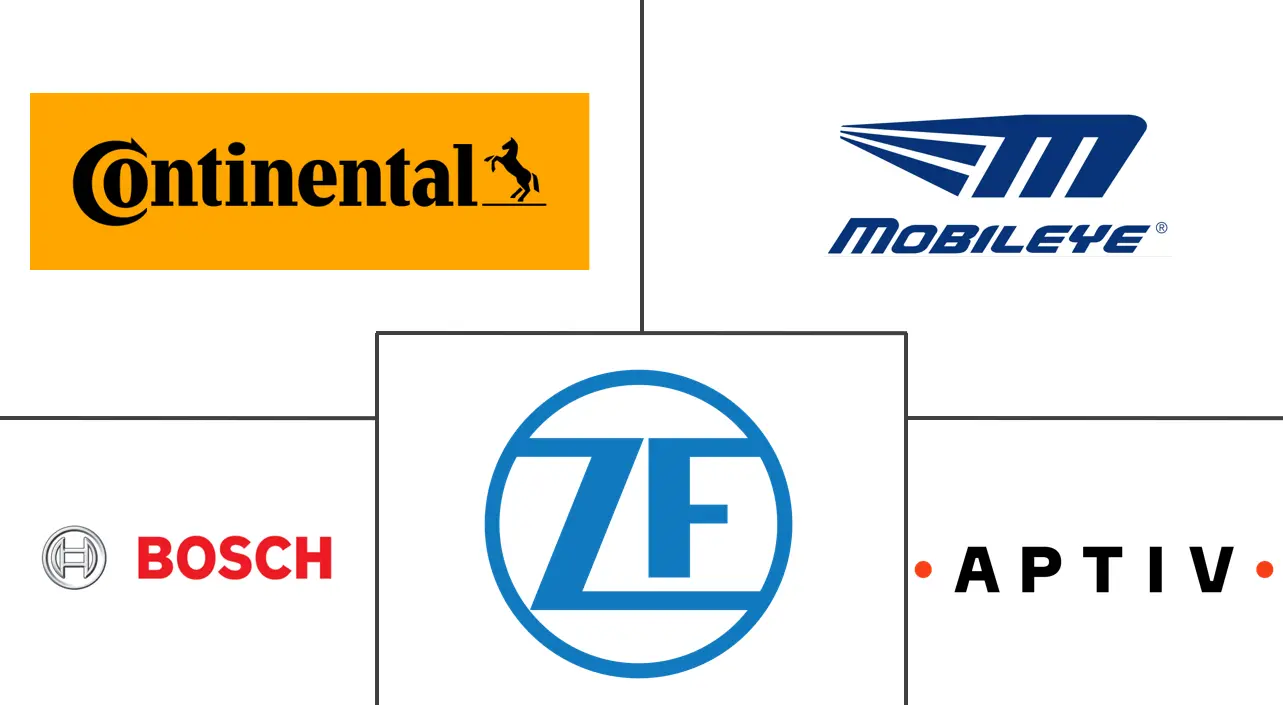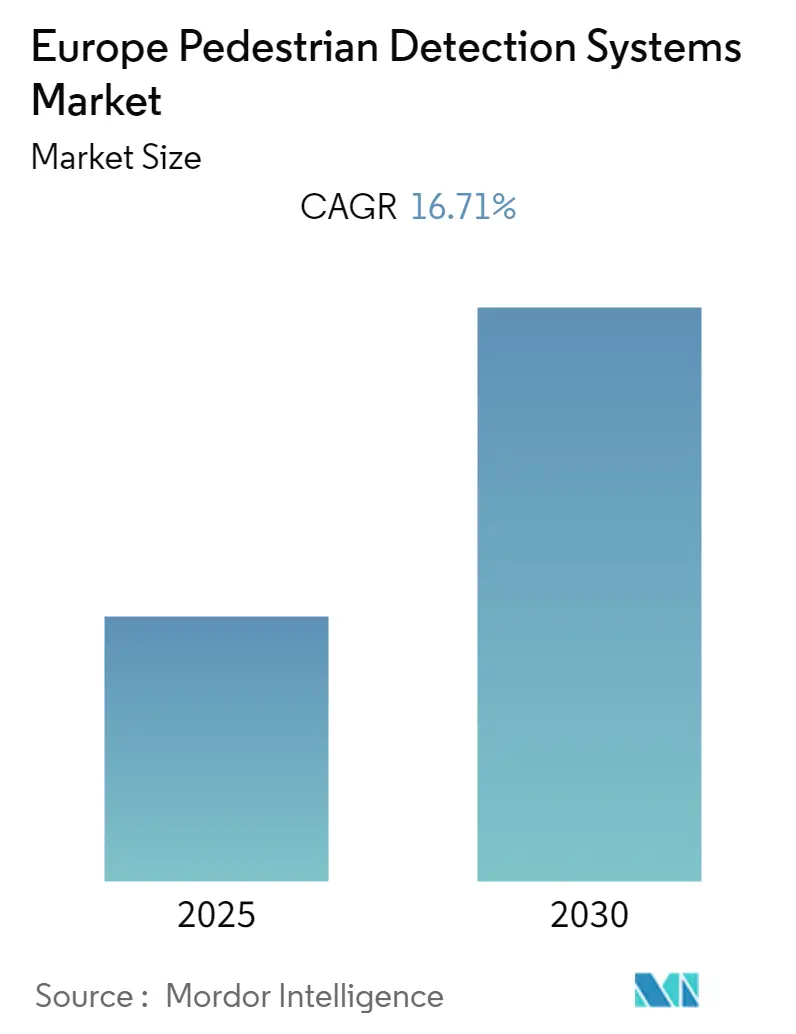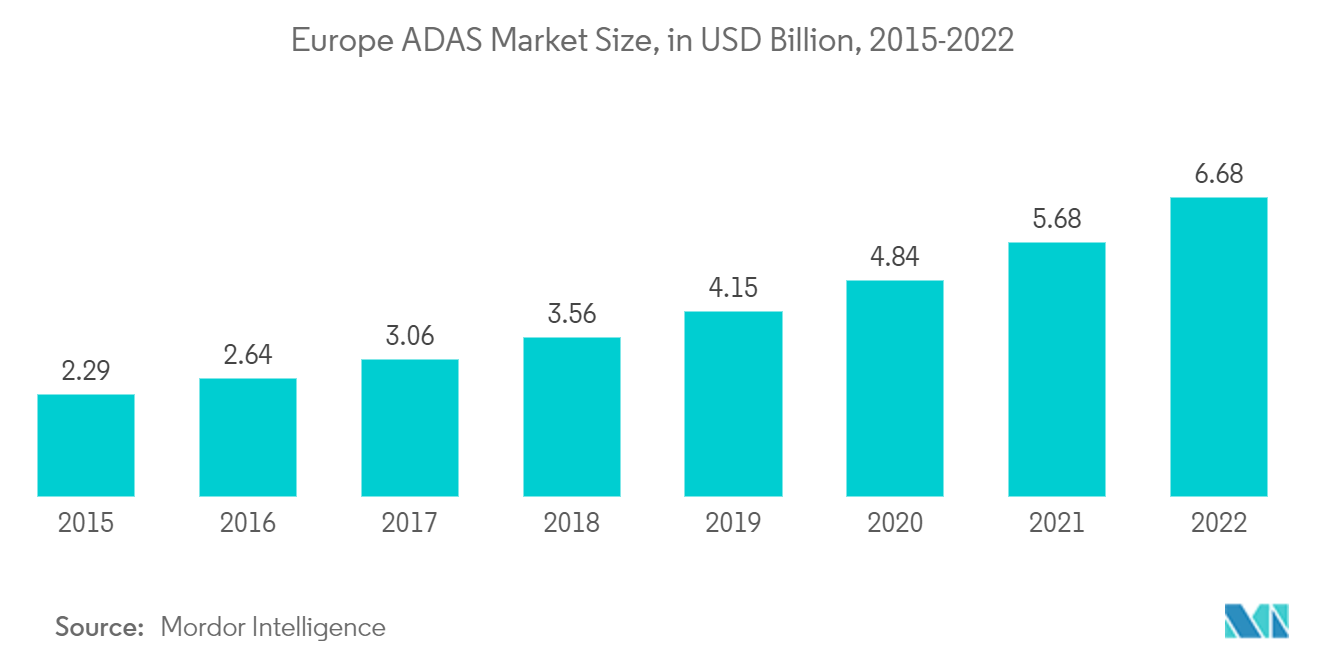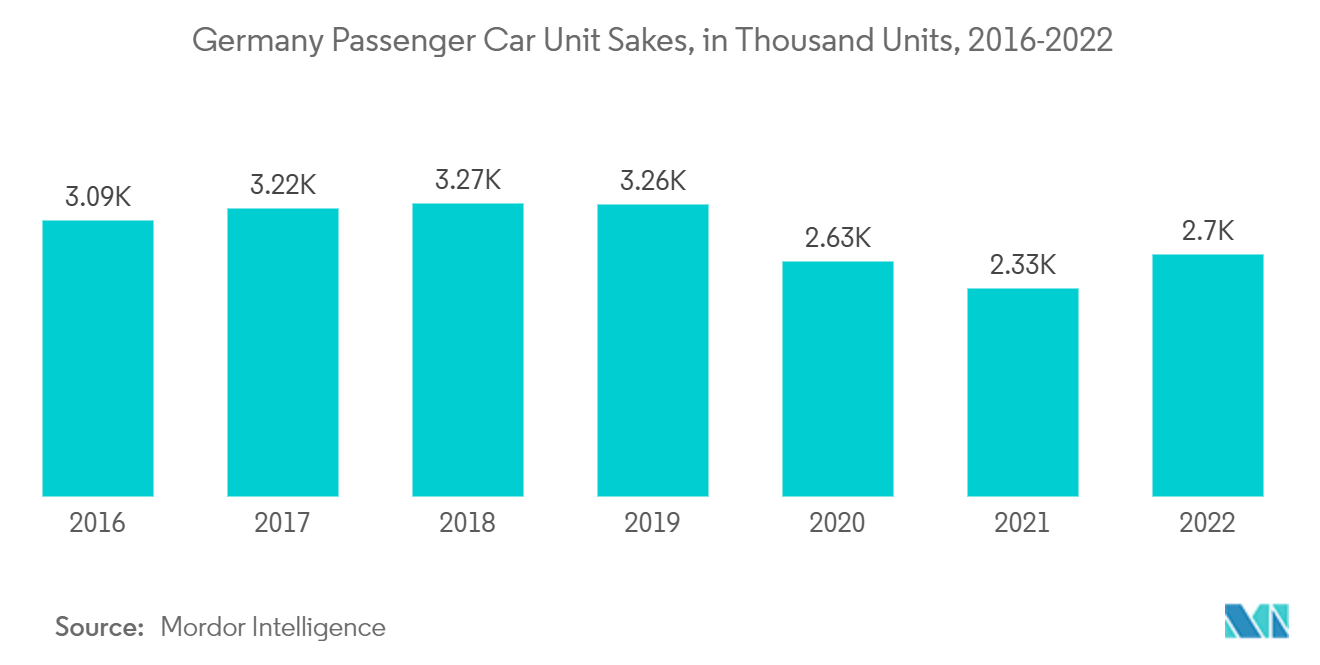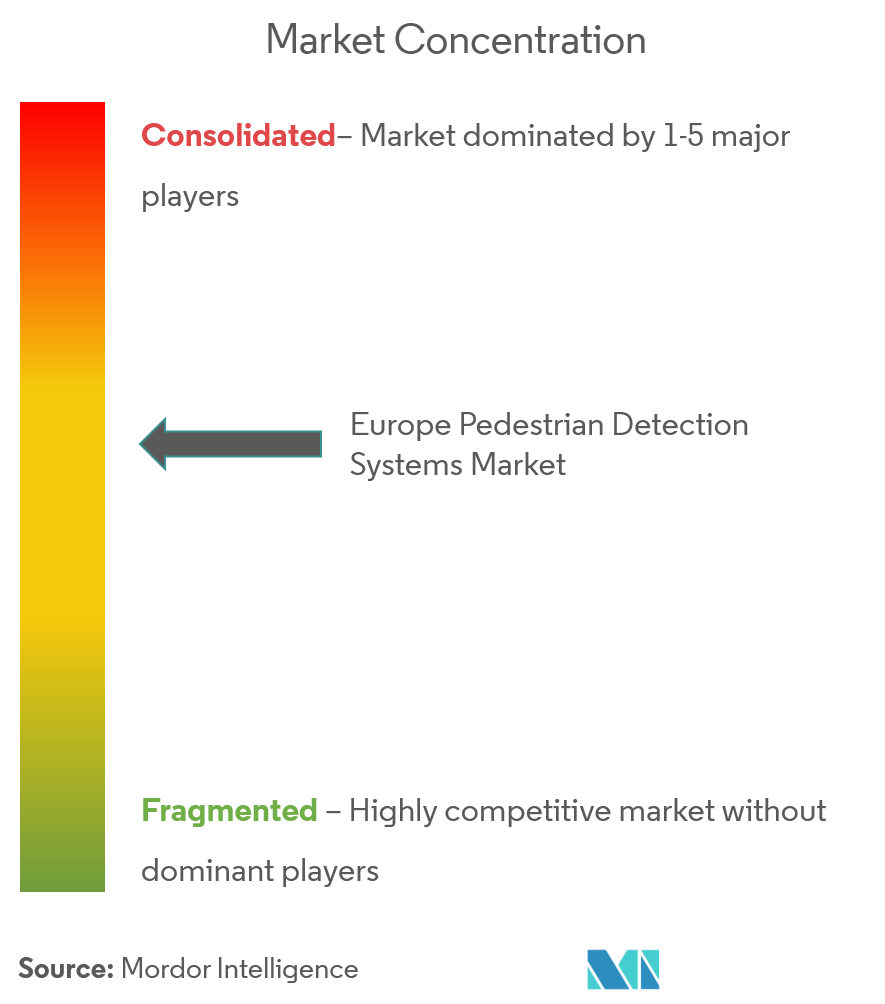Europe Pedestrian Detection Systems Market Analysis
The Europe Pedestrian Detection Systems Market is expected to register a CAGR of 16.71% during the forecast period.
- The COVID-19 pandemic harmed the market studied as lockdowns and trade restrictions led to supply chain disruptions and a halt of vehicle production across the world. However, as restrictions eased, players started focusing on mitigating such risks and developing strategies to create momentum in the market during the forecast period.
- Over the long term, growing safety concerns and government regulations regarding passenger and pedestrian safety, along with the increase in demand for premium vehicles, are some of the driving factors of the market. Over the years, there has been significant growth in the number of vehicles on the road and the construction of roads, resulting in a higher rate of road accidents. Pedestrians account for one-fifth of all traffic deaths in the European Union (EU). This proportion was larger than for other vulnerable road users, such as bicycles (9%), mopeds (3%), and motorcycles (16%).
- The pedestrian detection system is an important component of the driver assistance system, which is developed to avoid collisions between the vehicle and pedestrians, especially while driving during night time. The night-time pedestrian detection system works by letting the driver of the vehicle know about the obstacles on the road with the help of a near-infrared (NIR) camera and its displaying unit.
- The market is expanding as a result of customers becoming more aware of the advantages of having pedestrian protection systems installed in vehicles for the safety of drivers, passengers, and pedestrians, as well as the rising number of traffic accidents around the world. The expansion of pedestrian protection systems is being fueled by rising consumer demand for high-end vehicles as a result of shifting consumer preferences. Bicyclists and other road users also gain from systems with improved features, which explains why solutions based on pedestrian protection are widely used worldwide. Major players are also focusing on enhancing the pedestrian system. For instance,
- In April 2022, Vauxhall upgraded its best-selling Corsa and Mokka model lines for 2023, providing them with a fresh look, an appealing combination of new technology, and an improved Mokka powertrain choice. The Corsa design models received enhancements, including a redesigned Automatic Emergency Braking system that now includes Pedestrian Detection.
- In February 2022, Opel continued its electric onslaught with the introduction of the new Astra Sports Tourer. The vehicle came equipped with numerous cutting-edge assistance systems as standard equipment, such as front collision warning with automatic emergency braking, pedestrian detection, lane departure warning, traffic sign recognition, drowsiness detection, and cruise control with intelligent speed limiters.
- Additionally, it is anticipated that increased government initiatives and ongoing technological innovation would fuel market expansion. Additionally, during the projection period, market participants would benefit from technical developments in the automotive sector.
Europe Pedestrian Detection Systems Market Trends
Increasing Adoption of ADAS Systems Driving the Market
- Advanced driver assistance systems (ADAS) are vehicle-based intelligent safety systems developed and deployed by vehicle manufacturers, which have the potential to improve road safety in terms of crash avoidance, crash severity reduction, and protection. Owing to a plethora of features offered by ADAS, like auto stability control, cruise control, traction control, and blind spot detection, among others, the demand for the installation of ADAS features in vehicles is likely to witness exponential growth over the forecast period.
- Simultaneously, governments in the region are focusing on designing several legislative policies and regulations to monitor the users and are proposing policies mandating and encouraging consumers to install ADAS components in vehicles to mitigate rising road accidents across several countries.
- The European Commission has announced that it has begun implementing the new Vehicle General Safety Regulation. It sets the legal basis for the approval of automated and completely driverless cars in the EU and includes a variety of required advanced driver assistance systems to increase road safety. It will assist in safeguarding passengers, pedestrians, and cyclists throughout the EU, saving over 25,000 lives and preventing at least 140,000 serious injuries by 2038.
- The Commission intends to establish technical standards for automated and connected cars this summer, with a special focus on automated vehicles replacing drivers on highways (level 3 automation) and fully autonomous vehicles such as urban shuttles or robotaxis (level 4 automation).
- The new standards will link Eurpean Union (EU) legislation with the new United Nations (UN)-level guidelines on level 3 automation, as well as approve new EU technical legislation for fully autonomous cars. The technical guidelines will encompass testing processes, cybersecurity requirements, data recording rules, safety performance monitoring, and incident reporting requirements for makers of fully autonomous cars.
- The new road safety measures include a variety of safety elements. Intelligent speed assistance, reverse detection with cameras or sensors, drive monitoring system (DMS), event data recorders, and an emergency stop signal should be available on all road vehicles (cars, vans, lorries, and buses). Cars and vans include additional features such as lane-keeping systems and automatic braking.
- Blind spot technology, alerts to avoid collisions with pedestrians or bicycles, and tire pressure monitoring systems are required on buses and trucks. The requirements will first apply to new vehicle types beginning July 6, 2022, and then to all new cars beginning July 7, 2024. Some of the new regulations will be expanded to encompass other types of road vehicles until 2029.
- Additionally, the European New Car Assessment Program (NCAP), a government-backed group that rates cars for safety, may require cars to have a driver-monitoring system in order to earn a five-star safety rating starting in 2023 or 2024.
Germany Leading the Pedestrian Detection Systems Market in Europe
- With the presence of luxury car makers, like Audi, BMW, Mercedes, etc., in the country, customers' preferences have shifted to vehicles with luxurious and advanced features from that of a conventional variant. These car manufacturers are focusing on the preferences of their elite customers for their new products.
- Installation of new plants by OEM suppliers in the country may evolve the market for driver safety systems significantly over the forecast period. An increase in the number of new plants in Germany to increase the implementation of ADAS systems in cars may lower the cost incurred on importing the systems, thereby driving the market for ADAS systems. For instance, Denso, a major automotive supplier, has set up DENSO ADAS engineering services GmbH in Germany to enhance the development of safety technology in vehicles to curb the rate of road traffic accidents.
- In June 2022, MAN Truck & Bus and its partners successfully concluded the CITY research and development project on autonomous driving in cities. Throughout the project, the partners tackled the diverse technical requirements of automated driving in challenging urban traffic conditions, which included interactions with motor vehicles, pedestrians, and cyclists.
- Various subprojects were undertaken to achieve these objectives, including the precise detection of the vehicle environment through a range of sensors, accurate comprehension of different traffic situations, and the appropriate derivation of courses of action. Additionally, the project focused on achieving precise localization within a few centimeters using digital maps and enabling seamless communication with other traffic participants.
- To reduce the number of accidents and fatalities, the Department of Transportation has made it compulsory to incorporate forward collision avoidance technology systems in vehicles from 2017 onward. This system has a combination of long-range detection (e.g., adaptive cruise control), short-range and wide-angle systems (e.g., pedestrian detection), and autonomous emergency braking. This regulation is anticipated to drive the market for pedestrian detection systems in the country over the forecast period.
Europe Pedestrian Detection Systems Industry Overview
Some of the key players in the market include Robert Bosch, Continental AG, ZF Friedrichshafen, Aptiv PLC, Autoliv, and others. They are entering into partnerships and planning to invest in the latest features.
An increasing number of automobile manufacturers companies are integrating sensors for pedestrian detection to enhance their product offerings. While most manufacturers are integrating sensors and cameras in new cars, other sensor-based companies are offering add-on sensors, which can be used in cars without pre-installed pedestrian detection systems. Latest developments in pedestrian detection systems in passenger cars include
In January 2023, ZF introduced its Smart Camera 6, designed for ADAS (Advanced Driver Assistance Systems) and autonomous driving applications. The Smart Camera 6 utilizes Mobileye's EyeQ6 processor, which boasts a 120-degree field of vision and enables over-the-air updates for system upgrades. In addition to this, ZF's Smart Camera 6 includes an image processing module (IPM) that facilitates 3D surround vision, interior monitoring systems, and other features, allowing for comprehensive multi-sensor environmental monitoring capabilities.
Europe Pedestrian Detection Systems Market Leaders
-
Continental AG
-
Mobileye Global Inc
-
Robert Bosch GmbH
-
ZF Friedrichshafen
-
Aptiv PLC
- *Disclaimer: Major Players sorted in no particular order
Europe Pedestrian Detection Systems Market News
- July 2022: Volvo Trucks announced the launch of a new safety technology aimed at improving road safety. The device utilizes twin radars on each side of the truck to recognize when other road users, such as bicycles, enter the danger zone. Known as the Side Collision Avoidance Support system, it alerts the driver by flashing a red light on the appropriate side mirror when something is in the blind spot area. If the driver signals a lane change with the turn signal, the red light starts to flash, and an audible warning sound is emitted from the side of the potential accident. This provides the driver with timely information and the option to apply the brakes, allowing, for example, a bike to safely pass.
- February 2022: Skoda Auto emphasized its commitment to prioritizing the safety of pedestrians and individuals on bicycles when developing new Skoda vehicles. During the development phase, over 200 separate pedestrian safety tests are conducted, with a focus on the most vulnerable parts of the human body in the event of an accident. The tests at the Aurel CZ laboratory simulate accidents involving adult or child head impacts on the bonnet or windscreen, thigh collisions with the bonnet, and lower leg impacts on the front bumper.
- January 2022: Ficosa revealed its plans to replace the front mirror with a camera system in future commercial vehicles made by MAN. The front camera, currently part of a larger system called OptiView, focuses on the area just in front of the driver's cab. This enhanced visibility allows the driver to spot pedestrians or cyclists, particularly when starting the truck, thereby improving safety and preventing collisions.
Europe Pedestrian Detection Systems Industry Segmentation
Pedestrian detection is a system where a radar sensor is built into the vehicle's grille, a camera is installed in front of the interior rear-view mirror, and a central control unit is used for detecting potential pedestrian collisions and avoiding accidents with complete auto braking. The radar detects anything in front of the car and calculates the distance between the object and the car.
The Europe pedestrian detection systems market is segmented by type (video, infrared, hybrid, other types), by component type (sensors, radars, cameras, and other component types), and by geography (Germany, United Kingdom, France, Russia, Spain, Italy, and Rest of Europe).
The report offers market size and forecasts for all the above segments in value (in USD).
| Type | Video |
| Infrared | |
| Hybrid | |
| Other Types | |
| Component Type | Sensors |
| Radars | |
| Cameras | |
| Other Component Types | |
| Geography | Germany |
| United Kingdom | |
| France | |
| Russia | |
| Spain | |
| Italy | |
| Rest of Europe |
| Video |
| Infrared |
| Hybrid |
| Other Types |
| Sensors |
| Radars |
| Cameras |
| Other Component Types |
| Germany |
| United Kingdom |
| France |
| Russia |
| Spain |
| Italy |
| Rest of Europe |
Europe Pedestrian Detection Systems Market Research FAQs
What is the current Europe Pedestrian Detection Systems Market size?
The Europe Pedestrian Detection Systems Market is projected to register a CAGR of 16.71% during the forecast period (2025-2030)
Who are the key players in Europe Pedestrian Detection Systems Market?
Continental AG, Mobileye Global Inc, Robert Bosch GmbH, ZF Friedrichshafen and Aptiv PLC are the major companies operating in the Europe Pedestrian Detection Systems Market.
What years does this Europe Pedestrian Detection Systems Market cover?
The report covers the Europe Pedestrian Detection Systems Market historical market size for years: 2019, 2020, 2021, 2022, 2023 and 2024. The report also forecasts the Europe Pedestrian Detection Systems Market size for years: 2025, 2026, 2027, 2028, 2029 and 2030.
Page last updated on: July 25, 2023
Europe Pedestrian Detection Systems Industry Report
Statistics for the 2025 Europe Pedestrian Detection Systems market share, size and revenue growth rate, created by Mordor Intelligence™ Industry Reports. Europe Pedestrian Detection Systems analysis includes a market forecast outlook for 2025 to 2030 and historical overview. Get a sample of this industry analysis as a free report PDF download.

